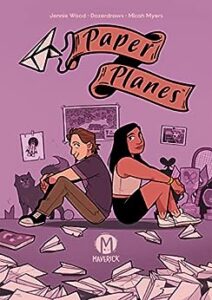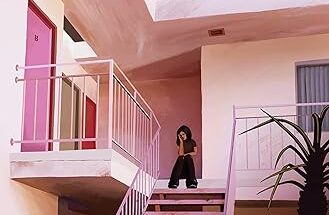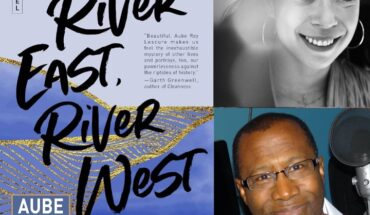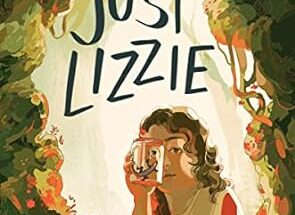 In Jennie Wood’s newest graphic novel, Paper Planes, illustrated by Dozerdraws, readers are dropped straight into one of the most quintessential summer settings, a camp bunkhouse. But former best friends Dylan Render and Leighton Worthington aren’t here by choice, as this is a camp for troubled teens, and a good evaluation at the end of the summer means the difference between attending high school with their friends, and spending the next four years at an alternative school.
In Jennie Wood’s newest graphic novel, Paper Planes, illustrated by Dozerdraws, readers are dropped straight into one of the most quintessential summer settings, a camp bunkhouse. But former best friends Dylan Render and Leighton Worthington aren’t here by choice, as this is a camp for troubled teens, and a good evaluation at the end of the summer means the difference between attending high school with their friends, and spending the next four years at an alternative school.
Described by Kirkus reviews as “A queer coming-of-age story that embraces the mess and complexity of identity and relationships”, Paper Planes is a richly layered story which captures all the joy and the heartbreak of growing up and growing apart, and will be surely be an important addition to the libraries of many queer readers.
I was honored to be able to speak with Jennie about the process of writing Paper Planes, as well as the inspiration behind some key moments in their book.
In your Next Chapters Interview with DeadDarlings you talked about how you wrote A Boy Like Me and Flutter in part because of your own gender dysphoria, and how the process of writing these books, and later attending queer writing and comic conventions, gave you the space to figure out your gender identity. How was the process of writing Paper Planes different, knowing now that you are nonbinary?
The process was actually quite different from a writing standpoint. There’s more of myself in this book because I’m living my authentic self. I grew up in a small town in South Carolina. So I didn’t grow up with the terms cisgender, nonbinary – I didn’t know those terms until I was exhibiting at comic conventions and talking to people about my very binary gender work Flutter and A Boy Like Me. I had to write the other books to get here. I had to write A Boy Like Me to ask myself if I’m trans, to really explore that, and to know that I wasn’t. So the process of Paper Planes was different because I knew who I was.
The book takes place the summer before high school, so I got to explore how Dylan, the nonbinary protagonist, is seen by the people around them, and what it might be like to be nonbinary at that young age, an experience I’ll never have. How they’re seen by the people around them is different than how I would have been seen at that age, and even how I’m seen now because I’m coming out later in life as nonbinary, so that was different. There’s more of me in this book than in the previous books. I’m more vulnerable talking about it because I feel more exposed.
What was it like collaborating with a nonbinary artist?
Working with a nonbinary artist was amazing, because I got to see the world that we were creating together through their eyes, through another nonbinary lens. As you know, all of us in the queer community have things in common, but we have very different identities, and so from Dozer, the artist, to me, we see things differently, but there’s some crossover, and it was just so great to see the characters and the world through their eyes as I’m coming out and exploring who I am as nonbinary person. The whole process was just such a gift.
Paper Planes deals with issues of identity and the intersection of multiple identities in so many different ways. It’s not simply about Dylan’s nonbinary identity, or Leighton’s asexuality. You delve into issues of class as well. I’d love to hear from you either about the process of writing characters at the intersections of these different identities, or why it was important for you to do so.
I think it’s so important to not just write characters that are nonbinary and asexual, but characters that are flawed, that have nuances. We are finally, I think, at a place where we’ve got a lot of queer representation, so we can get really into the nuances beyond, this person has to be all good, or this person has to be all bad, or that the most interesting thing about them is that they’re nonbinary or asexual. I want them to be as layered as possible, and also relatable, and one thing I think that so many people can relate to is class. It’s something that always needs to be addressed and unfortunately will need to be addressed for years to come and it was something that affected me.
Tennis plays out a lot in this book and it was a big part of my life as a kid. I loved tennis but I was also very uncomfortable on the girls’ tennis team, and when I was coming out as nonbinary and starting this book, I was like, well obviously I was uncomfortable because I was nonbinary and I was on the team with girls. And that was very true, but also I was also very poor. I was very, very working class and all the other girls on the team were from wealthier families. Most of them learned how to play tennis at the country club. One of them had a tennis court in her backyard. I learned how to play on my dad’s wooden racket against an abandoned building, hitting the ball, standing in the middle of the street.
Because I didn’t know I was nonbinary at the time – I just knew I didn’t fit in with these girls – class was quite possibly the bigger element, in terms of how in my face it was. My grade school friend and I grew apart in high school, and that was class. You get to high school and suddenly the wealthier friends are going skiing on the weekends and I’m working in the movie theater. Unfortunately, it’s such a big divide in our country, and so I always want to write about queer characters, and I also always want to write about class, because I think it’s just a big important issue, and something everyone can relate to.
Without spoiling the ending, Paper Planes is really a story about friendship and the way it evolves and changes as individuals grow and change. I think what Dylan and Leighton go through, and particularly where they end up, is a really common experience for many young people. Can you talk about the process of writing about their friendship? Was their friendship inspired by any in your own life?
It’s inspired by a grade school friendship, one I grew apart from in high school. She passed away in 2020, shortly before I wrote this book. When she passed away, I went down this rabbit hole of how important grade school friendships are in general. I rewatched Stand by Me and reread The Body, but I also went down memory lane and I could remember things that I’ve carried around with me for years about that friendship. We tend to hold onto the negative memories, and I remember I wrecked her go-kart on her birthday. She had just gotten this go-kart and I wrecked it. I just flipped it. I can still hear her yelling at me, and so I put that scene in Paper Planes through a different context. Actually since I wrote that scene and Dozer’s drawn it, I don’t hear her yelling at me anymore. So it’s very cathartic, very healing.
That’s one example. Another example is my second grade birthday party. My mother, even though we didn’t have the money, invited my whole class, and I overheard my friend say that she didn’t want to be there, and I didn’t want to be there either. I used that in Paper Planes, again in a different context, but once I wrote that I was able to let it go. I don’t carry these things around anymore.
Writing doesn’t always have to be cathartic but when it can be healing, it’s so, so great.
It’s wonderful when that can happen. It’s also interesting how you talk about using these moments from your life, but changing them for Dylan and Leighton. Are there other ways their friendship evolved and became something you didn’t expect when you first began writing? Or other characters?
Yes. I didn’t start out to have Leighton be asexual. She kind of told us she was over the course of writing her. I do a long character bio of my characters and as she was interacting with Dylan, it became clear that this is who she is, she’s not into Dylan in this way. She’s not into anyone else in this way. She loves Dylan but for her, it’s not a romantic or a sexual love. And that is a way of your character just telling you who he, she, or they are. And then Cricket wasn’t in my original outline.
I love Cricket, so much.
A great writing example right? I had written out the whole character bios, the summary, the outline, and then the publisher, the great braintrust that is Mad Cave and Maverick, they were like, we love Dylan and Leighton, we love all the supporting characters, but we need some levity. We need some fun, we need some bright spots, especially for Dylan. And so I sat down, it was late on a Thursday night, and I wrote a bio for Cricket. Sometimes I think we do our best work when we are tired and not thinking too much. And I think she definitely elevates the book to another level.
If there’s just like a Cricket book or side story in you, I think I am speaking for many people who will read Paper Planes and saying, I’m there for that, you know? Just saying.
She was a lot of fun to write!
Paper Planes has an intricate structure – the story often flashes back to moments in Dylan and Leighton’s past, from the start of their friendship in third grade, to the incident that led to their time at a summer camp for troubled youth, and through different text boxes, we get narration from both characters.
I know from personal experience how difficult it can be to figure out the balance of a story that moves back and forth like this one does. What was the process like of figuring out what moments to share in each timeline, and when to jump back and forth?
So much of that came from our great editor, Erica Schultz, who happened to be a long time friend of mine working at Mad Cave at the time. She helped Dozer and I with the pace and knowing when to cut scenes. Erica is also a fantastic writer in comics. She’s currently writing for Marvel and Image, so she’s very well versed in all this.
As for the narration, I wanted to bounce back and forth between Dylan and Leighton chapter after chapter, but I didn’t know how we were going to differentiate in the text. Erica had the idea of the spaceship representing Dylan’s dialogue, and the roller skate representing Leighton’s dialogue, because those two images are connected to them, and that was a great idea. Again, this is all about having a great team putting your book together, whether it’s prose or with comics / graphic novels.
And then Dozer had the idea – which was also fantastic – of the flashbacks being in a different color palette – more faded, more muted, softer colors. They also put a texture over the sheet, so it looks a little older, like an old photograph. And I actually think that’s more effective than any caption we could have that says Two Years Ago. Those captions are there, but sometimes especially late at night, you’re reading this stuff and you miss those. Dozer’s device of changing up the colors from past to present felt very authentic and works very well with the book.
As I think both of us know all too well, it’s a particularly difficult time in the world, and in our country, to exist as a trans or nonbinary person. There’s also more ways for people, especially young people, to see themselves represented, including through media such as this graphic novel.
Do you have other queer / trans / nonbinary book, comic book, graphic novel, etc recommendations you’d like to share? Things you’ve enjoyed, or are looking forward to?
I’m looking forward to your book, so let’s get that right in there! I really really am, ever since you first told me about it last October? It was at Kelly Ford’s last book launch, she’s got another book launch coming up, but yeah I think it was last October. Ever since you told me about it, I’ve been very much looking forward to your book.
On a different front, I am just starting Elliot Page’s memoir, Pageboy, and it is amazing. I’m 50 pages into it but I’m getting goosebumps talking to you about it, and I just think that it’s a great book for people to pick up this summer.
Do you have any words you’d like to share with young queer people as they navigate this time in their lives?
It is a difficult time, it’s why we need these stories more than ever. People, especially young queer people, need to see themselves on pages, or some element of themselves. They need to know that adults are there for them, are doing stories for them. We see them, and books are under attack, so we just need to keep putting them out, so that people will see that we aren’t going away.
If I could tell a young queer person anything it would be not to let anyone tell you who you are, and most importantly, not to let anyone tell you that you don’t deserve love, because you deserve to be loved how you want, and for whoever you choose to be, whoever you are.
I love that, and I think there’s something I’ve come to appreciate in myself as I came out is that it’s not just that we deserve love, it’s that these things about us, that make us us, are loveable.
Yeah. We are loveable. You saying that, just kind of nails it. The queerness, the uniqueness that we bring to the world is very loveable. We are very loveable people. So yeah, it goes beyond deserving of love, that’s great. I love how you put that.
With Paper Planes officially out in the world on August 22nd, what’s next for you?
I am currently just beginning a new graphic novel, and revising a new young adult novel but more immediately is being a part of the next John Carpenter’s Halloween Nights anthology that comes out in September. And that’s horror and it’s adult and it’s much different from the deeper young adult material that I love to do, but I find that the variety helps. It’s nice to take a minI break from that and write a horror story once in a while.
That sounds awesome. Last– and perhaps most important question of all – how good is your paper plane making game?
That is a great question! No one has asked me that!
How? It’s so obvious!
I know! Mine is okay. The publisher sent me this How to Make a Paper Plane one-sheet flier that takes you through it, and I had them for Haverhill Public Library’s Comic Con in May. Me and another guest at the con were trying to make them, and by the end of the day, I was getting to where I could make it soar a few feet. I can’t make it come back to me, but I’m getting there. Maybe by the end of the summer I’ll be able to make it do flips and come back to me. I’ve never seen that, so we’ll see if it happens!
Jennie Wood is a non-binary author, comic creator and musician. They created the critically acclaimed, award-winning Flutter graphic novel series. Flutter was named one of The Advocate’s best LGBTQ graphic novels of the year, a Barnes & Noble Book of the Month, an INDIEFAB Book of the Year finalist, and a Virginia Library Association Diversity Honor Book. In 2018, Dark Horse published The Flutter Collection, the entire series in one book, which won the Next Generation Indie Book Award for Best Graphic Novel of the Year. Jennie is also the author of the award-winning YA novel, A Boy Like Me. Their work can be seen in several anthologies, including The New York Times best-selling FUBAR, the Eisner award-winning anthology Love is Love, Planet Comics, and John Carpenter’s Tales for a HalloweeNight. Published by Maverick, Jennie’s latest graphic novel, Paper Planes, won the 2023 Next Generation Indie Book Award for Young Adult Fiction (12 – 16 years) and the 2023 IPPY Bronze Medal in Young Adult Fiction (General Category). For more: jenniewood.com




1 comment